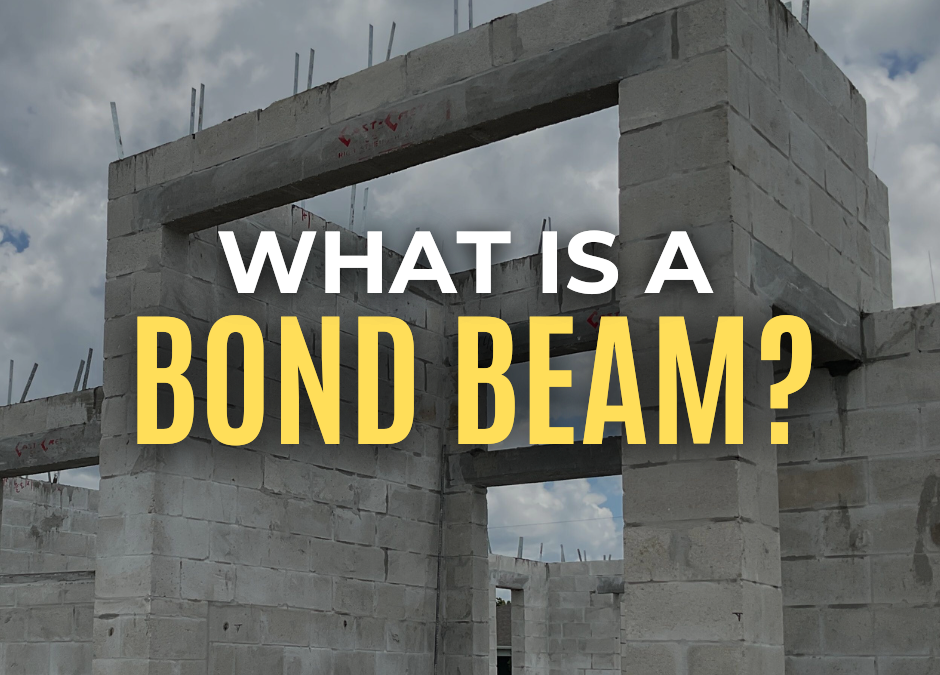A bond beam is a horizontal reinforced concrete element that runs along the top of a masonry wall. It is designed to tie the structure together, distributing loads evenly and increasing the overall strength and stability of the home. Think of a bond beam as the framework that reinforces the top of your walls, helping them resist lateral forces from wind and other environmental pressures.
The Importance of Bond Beams in Florida Homes
Florida’s unique climate presents specific challenges that make bond beams indispensable in residential construction:
-
Hurricane Resistance
The state frequently faces powerful hurricanes with intense winds that exert significant lateral forces on buildings. Bond beams enhance structural integrity by reinforcing masonry walls, preventing collapse, and ensuring that the load is distributed evenly across the structure.
-
Wind Mitigation Benefits
Wind mitigation refers to construction techniques that reduce wind damage during storms and hurricanes. Bond beams are crucial in wind mitigation by increasing a home’s structural rigidity, reducing uplift forces, and ensuring that walls remain securely anchored under high winds. Homes built with proper bond beam construction are more likely to qualify for insurance discounts due to improved wind resistance ratings.
-
Prevention of Wall Separation and Cracking
Over time, natural settling or external pressures can cause walls to shift or develop cracks. Bond beams act as a stabilizing force, maintaining the correct positioning of walls and reducing the risk of structural issues that could compromise the home’s integrity.
-
Enhanced Load Distribution
Bond beams help evenly distribute vertical and horizontal loads across the structure, reducing the risk of localized stress points that could weaken the home over time. This makes them particularly beneficial in areas with shifting soil conditions.
-
Structural Connection for Roof Systems
Bond beams serve as a critical connection point between masonry walls and the roof system. They help anchor the roof structure, reducing the risk of uplift during hurricanes and ensuring that the entire building acts as a unified system.
-
Compliance with Florida Building Codes
Bond beams are a requirement under Florida’s strict building codes for hurricane-prone areas. Their inclusion in masonry structures ensures compliance with modern engineering standards for wind resistance and structural stability.
Materials Used in Bond Beam Construction
The choice of materials for bond beams significantly influences their effectiveness and durability:
- Reinforced Concrete: A common choice due to its strength and durability, making it ideal for areas prone to severe weather.
- Steel Reinforcement (Rebar): Embedded within the concrete, rebar provides additional tensile strength, helping the bond beam withstand dynamic forces and reinforcing its overall stability.
When Are Tie Beams Used?
While bond beams are a standard part of Florida home construction, tie beams are also used in specific applications, such as for 90-degree sliding glass doors. In these cases, tie beams provide additional support, preventing movement and ensuring structural integrity around large openings.
Conclusion
Incorporating well-designed bond beams is not just a construction preference but a necessity for homes in Florida. They play a vital role in enhancing structural integrity, ensuring safety, and prolonging the lifespan of your home. Understanding the role of both bond beams and tie beams in home construction helps homeowners make informed decisions about their new build or renovation.
For more insights into our construction practices and how we ensure the highest standards of safety and quality, explore our detailed comparison on Stem-Wall vs. Monolithic Foundations.

